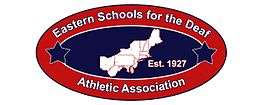Eastern Schools for the Deaf Athletic Association

| Abbreviation | ESDAA |
|---|---|
| Formation | 1927 |
| Legal status | Association |
| Purpose | Athletic/Educational |
Membership | 17 Deaf Schools |
Official language | ASL & English |
| Affiliations | National Federation of State High School Athletics Association (NFSHSAA) & National Deaf Interscholastic Athletic Association (NDIAA) |
| Website |
The Eastern Schools for the Deaf Athletic Association (ESDAA) is an organization that oversees and regulates interscholastic athletics in the US States of Delaware, Maryland, West Virginia, Ohio, Pennsylvania, New Jersey, New York, Connecticut, Rhode Island, Massachusetts, and Maine. The ESDAA is headquartered at the New Jersey School for the Deaf in Trenton, New Jersey. ESDAA is the oldest Deaf High School Athletic Association in the U.S., founded in 1927.
Members
- Lexington School and Center for the Deaf (Queens, New York)
- New York School for the Deaf (White Plains, New York)
- American School for the Deaf (West Hartford, Connecticut)
- Western Pennsylvania School for the Deaf (Edgewood, Pennsylvania)
- Pennsylvania School for the Deaf (Philadelphia, Pennsylvania)
- Marie H. Katzenbach School for the Deaf (Trenton, New Jersey)
- Maryland School for the Deaf (Frederick, Maryland)
- Delaware School for the Deaf (Newark, Delaware)
- Ohio School for the Deaf (Columbus, Ohio)
- Rochester School for the Deaf (Rochester, New York)
- West Virginia Schools for the Deaf and Blind (Romney, West Virginia)
- St. Mary's School for the Deaf (Buffalo, New York)
- New York State School for the Deaf (Rome, New York)
- Mill Neck Manor School for the Deaf (Mill Neck, New York)
- Marie Philip School - The Learning Center for the Deaf (Framingham, Massachusetts)
- Rhode Island School for the Deaf (Providence, Rhode Island)
- Governor Baxter School for the Deaf (Mackworth Island, Maine)
Former Members
- Austine School (Brattleboro, Vermont)
- Scranton School for Deaf and Hard-of-Hearing Children (Scranton, Pennsylvania)
- Model Secondary School for the Deaf (Washington, D.C.)
- Virginia School for the Deaf and the Blind (Staunton, Virginia)
- St. Joseph's School for the Deaf (New York City, New York)
- Kendall School (Washington, D.C.)
Sports
- Basketball
- Cheerleading
- Soccer - (Boys')
- Track and Field
- Volleyball - (Girls’)
- Wrestling
Trivia
- ESDAA is the oldest Deaf High School Athletic Association in the U.S., founded in 1927.
- From 1927 to present, twenty-three school was member of ESDAA, only 17 schools still remains to today.
- Ohio School for the Deaf is the most recently added as member of ESDAA, joined in 2015.
- In 1927, Fred Moore, a teacher at the Marie H. Katzenbach School for the Deaf in New Jersey, organized the first boy’s basketball tournament.
- The nine participating schools in this first boys basketball tournament included; Kendall, Fanwood, Pennsylvania, American, New Jersey, St. Joseph’s, Lexington, Virginia and Maryland.
- The Katzenbach School (New Jersey) emerged as the first team to wins ESDAA's boy's basketball champion.
- The trophy presented to the winner of the ESDAA Div I tournament is known as the George Harlow Trophy; the winning team keeps this trophy for one year and passes it on to the winner the following year. Hence, it is called a “traveling trophy”.
- The girls' basketball tournament was first formed in 1977. The first ESDAA girls’ basketball tournament was hosted by the Maryland School for the Deaf and the first girls basketball team to win champion was Model Secondary School for the Deaf. In 1979, only two years after formed the first girls basketball tournament, now formed into two divisions.
- The girls' volleyball tournament was first formed in 1981, and Model Secondary School for the Deaf was the first team to win volleyball tournament champion.
- The first Division II girls' volleyball tournament was held in 1999, and Delaware School for the Deaf was the first team to win ESDAA Division II volleyball title.
- In 1994, the boys' basketball was formed into three divisions. Then was formed back to two division in 2008 and still remains to today.
References
External links
This article is issued from
Wikipedia.
The text is licensed under Creative Commons - Attribution - Sharealike.
Additional terms may apply for the media files.